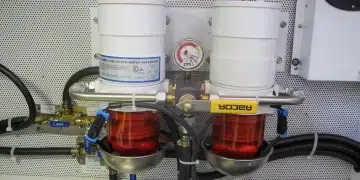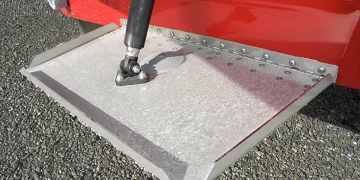Marine Generator Maintenance: Helpful Tips You Need To Prevent Issues

Watch the podcast or read below:
Out of sight? Out of mind.
Many generators are housed inside a sound shield box to reduce engine noise. This box lets you quietly power the air conditioners while you sleep aboard. This same box also restricts visual awareness of the unit. Your propulsion engine can be easily observed for problems in the wide-open space. But your generator is often out of sight and out of mind. Nonetheless, marine generator maintenance is a topic that cannot be overlooked.

Discover When You Uncover
Daily engine room fluid checks are essential. These inspections should also include your generator. But you can’t check what you can’t see. So, if your generator is surrounded by a sound shield, you must uncover to discover the status quo.
Some shields have an inspection port to access dip sticks for daily checks. But you may want to view more than that so opening the shield could require more effort. This is worth it because you can then check belt tension, oil and coolant levels, or any signs of leaks. Drips may be a warning of an impending problem. Raw cooling water, coolant (anti-freeze), oil, or fuel leaks are all designed to be captured in the drip pan below the generator. Fortunately, the coolant anti-freeze container may be outside the sound shield to see easily.
Subscribe Here For Weekly Updates
Marine Generator Maintenance “Daily DOs”
Pull your generator’s oil dipstick daily to check for level and color. If the oil is discolored by raw water, it may look like chocolate milk. Fuel contamination gives your oil a fuel aroma but also may have tiny bubbles as a telltale. Use your finger to tug on the alternator water pump belt to note proper tension. Loose belts may show signs of black belt dust, a precursor to a belt breaking, engine overheating, and automatic shutdown.
Visually inspect the raw-water pump. Look for any leakage in the open ports between the drive mechanism and the rubber impeller housing. Water leaking out may be due to a bigger concern of air being sucked in. Air bubbles destroy the rubber impeller vanes, leading to an overheating issue.

Marine Generator Maintenance “Occasional DOs”
Maintenance includes shorter oil change cycles since the unit may only hold one gallon of oil. Some marine generators require oil and filter changes every 100 hours. Look for the pencil zinc rod inside the heat exchanger, just like on your propulsion engine.
Get creative so you can see the exhaust elbow located between the engine and armature. Here, the raw water is injected into the hot exhaust gases to cool before traveling through the rubber hose toward the water lift muffler. Signs of rust indicate that replacing the exhaust elbow is in the near future.
Fire Protection
Since we see most generators inside a sound shield, automatic fire protection is difficult. Look for a port on your sound shield where a handheld fire extinguisher nozzle can have access. This feature may allow a fire to be extinguished without removing the shield. Other installations might have a fire suppression system and sensor built inside the sound shield itself.
Start Your Generator!

Before pressing start, make sure there is no electrical load. The circuit breaker should be OFF or on SHORE POWER. Push the start button and let the computer run through a diagnostic procedure. Voila! Your generator is running.
A manual start process is different. Press and continually hold the preheat switch for about 30 seconds. The preheat switch also turns off the low oil pressure safety system. The generator will never start if the low oil pressure system is not bypassed using the preheat feature. While you continue to hold the preheat switch, engage the start switch.
As soon as the engine starts, release the start switch. But, continue to hold the preheat switch until the engine is running and sounds smooth. Then release the preheat switch. Some generators have electric fuel pumps and make a rattle noise during the preheat phase. This is normal.
Excessive attempts to crank the engine may cause hydrolock and destroy the engine. Continued unsuccessful attempts to start the generator may pump raw water through the system into the water lift muffler which may back up into the cylinder.
Shift Power
Once the engine warms up and is running smoothly, it’s time to shift power from the shore to your marine generator. Listen to the generator. When a heavy electrical demand starts, such as an air conditioner, the generator will momentarily drop rpms then quickly recover to maintain 1,800 rpms. You may hear this normal drop and recovery throughout the night as the air conditioner cycles on and off.
Be sure the large air conditioner circuit breaker is on to provide your power supply. Someone may have accidentally tripped the breaker when moving nearby.
When you no longer need a power supply from your marine generator, get ready to shut it down. Before turning it off, first remove all electrical loads. Then move the selector switch to shore power before turning any electrical equipment back on.
Keep mindful of your marine generator, and you won’t mind doing a little DIY preventive maintenance.
-by Capt. Chris Caldwell
Related Posts
var jnews_module_54584_2_66e2c0d2cc21c = {“header_icon”:””,”first_title”:”Related”,”second_title”:” Posts”,”url”:””,”header_type”:”heading_6″,”header_background”:””,”header_secondary_background”:””,”header_text_color”:””,”header_line_color”:””,”header_accent_color”:””,”header_filter_category”:””,”header_filter_author”:””,”header_filter_tag”:””,”header_filter_text”:”All”,”sticky_post”:false,”post_type”:”post”,”content_type”:”all”,”sponsor”:false,”number_post”:{“unit”:”px”,”size”:6,”sizes”:[]},”post_offset”:0,”unique_content”:”disable”,”include_post”:””,”included_only”:false,”exclude_post”:54584,”include_category”:”6173″,”exclude_category”:””,”include_author”:””,”include_tag”:””,”exclude_tag”:””,”category”:””,”post_tag”:””,”jobpost_category”:””,”jobpost_job_type”:””,”jobpost_location”:””,”jobpost_tag”:””,”sort_by”:”latest”,”date_format”:”default”,”date_format_custom”:”Y/m/d”,”force_normal_image_load”:””,”pagination_mode”:”disable”,”pagination_nextprev_showtext”:””,”pagination_number_post”:{“unit”:”px”,”size”:6,”sizes”:[]},”pagination_scroll_limit”:{“unit”:”px”,”size”:3,”sizes”:[]},”boxed”:””,”boxed_shadow”:””,”el_id”:””,”el_class”:””,”scheme”:””,”column_width”:”auto”,”title_color”:””,”accent_color”:””,”alt_color”:””,”excerpt_color”:””,”css”:””,”excerpt_length”:{“unit”:”px”,”size”:20,”sizes”:[]},”paged”:1,”column_class”:”jeg_col_3o3″,”class”:”jnews_block_9″};
The post Marine Generator Maintenance: Helpful Tips You Need To Prevent Issues appeared first on Southern Boating.











